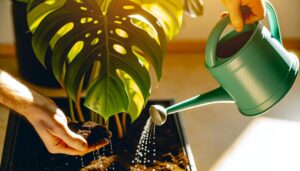Can I Plant Two Monsteras Together? Gardening Advice!
You can plant two monsteras together, benefiting from increased humidity, mutual support, and efficient space use. Guarantee sufficient root space and monitor light and water needs to avoid overcrowding.
Regular pruning and drainage are essential to maintain health. Be cautious of root competition and disease risks; keep an eye on growth patterns to provide equal light and avoid entanglement.
Choose a large pot with proper drainage and use a well-aerated soil mix. Consistent soil moisture and balanced fertilization are key to fostering robust growth.
For more nuanced insights into maintaining thriving monsteras, there’s much more to uncover.
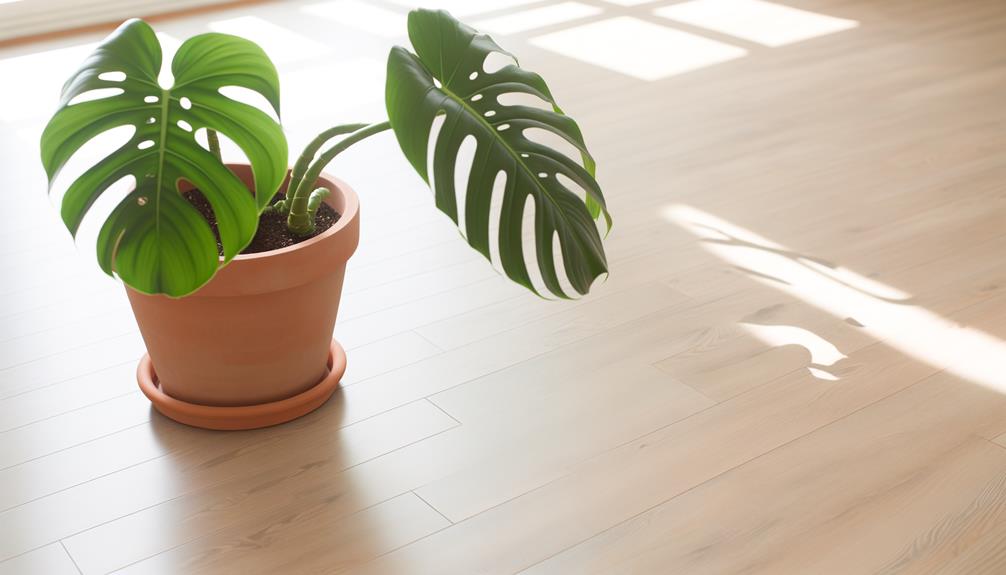
Key Takeaways
- Yes, planting two Monsteras together can enhance aesthetic appeal and increase humidity levels.
- Ensure adequate space for root development to prevent overcrowding and root entanglement.
- Monitor light and water requirements closely to avoid competition for resources.
- Regularly check for signs of disease or pests to maintain plant health.
- Be prepared to separate the plants if growth patterns become incompatible or issues arise.
Benefits of Planting Together
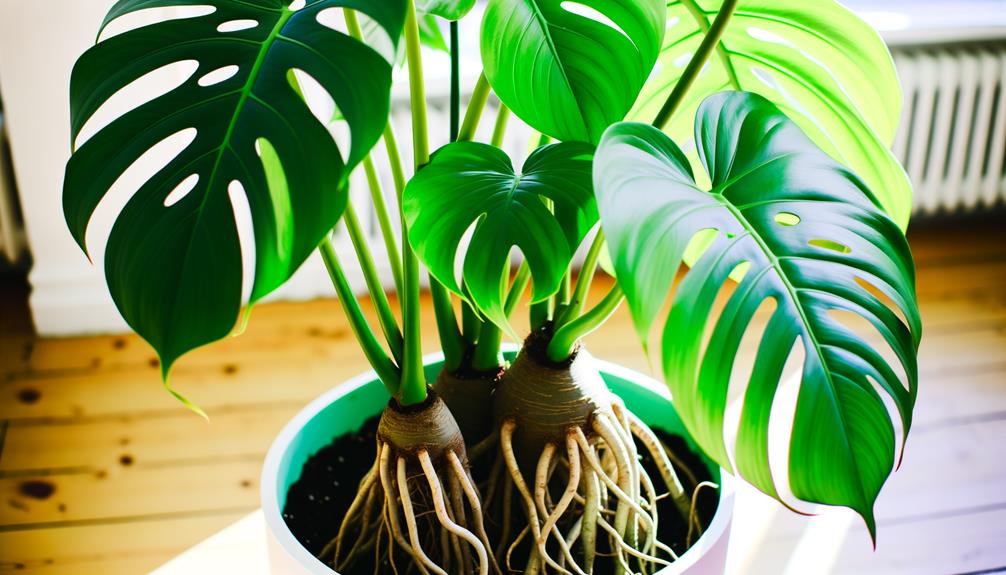
When you plant two Monsteras together, you can optimize their growth by creating a microenvironment that enhances humidity and promotes healthier root development.
By clustering them, you essentially replicate their natural living space, where dense foliage maintains higher moisture levels. This increased moisture supports stomatal function and photosynthesis efficiency.
In addition, shared soil space allows for a more stable root zone temperature, which is essential for enzymatic activities and nutrient absorption. The proximity also encourages mutualistic interactions among root systems, such as mycorrhizal associations that enhance nutrient uptake.
Moreover, this setup can decrease water evaporation rates from the soil, ensuring consistent hydration. By utilizing these benefits, you cultivate an environment where both Monsteras can thrive, resulting in lush foliage and robust growth.
Root Competition Concerns
When planting two Monsteras together, you must consider root competition as it can lead to nutrient absorption issues and space allocation problems. The roots may compete for essential minerals, potentially stunting overall growth.
Additionally, inadequate root space can cause entanglement, leading to mechanical damage and reduced plant health.
Nutrient Absorption Issues
Root competition between two Monsteras planted together can lead to significant nutrient absorption issues, potentially stunting their growth. When their roots compete for the same nutrients, you’ll see deficiencies in essential elements like nitrogen, phosphorus, and potassium.
This competition can manifest in several ways:
- Chlorosis: Yellowing leaves due to inadequate nitrogen.
- Stunted growth: Limited phosphorus reduces energy transfer.
- Weak stems: Potassium deficiency impacts overall plant vigor.
To mitigate these issues, make sure your soil mix is nutrient-rich and consider supplemental feeding. Regularly check for signs of nutrient stress, like discolored leaves or slowed growth.
Space Allocation Problems
Space allocation issues arise as the roots of multiple Monsteras compete for limited underground real estate, leading to restricted growth and potential stress on the plants. When you plant two Monsteras together, their root systems vie for necessary resources such as water, oxygen, and nutrients. This competition can hinder root expansion and overall plant vigor.
You’re likely to observe stunted growth, yellowing leaves, and reduced turgor pressure. It’s essential to understand that Monsteras have extensive root structures that require sufficient space for optimal development. Without ample room, root entanglement is inevitable, worsening the competition for resources.
To address these issues, consider using larger containers or ensuring adequate spacing in your planting arrangement, promoting healthier growth and preventing root-bound conditions.
Growth Patterns to Consider
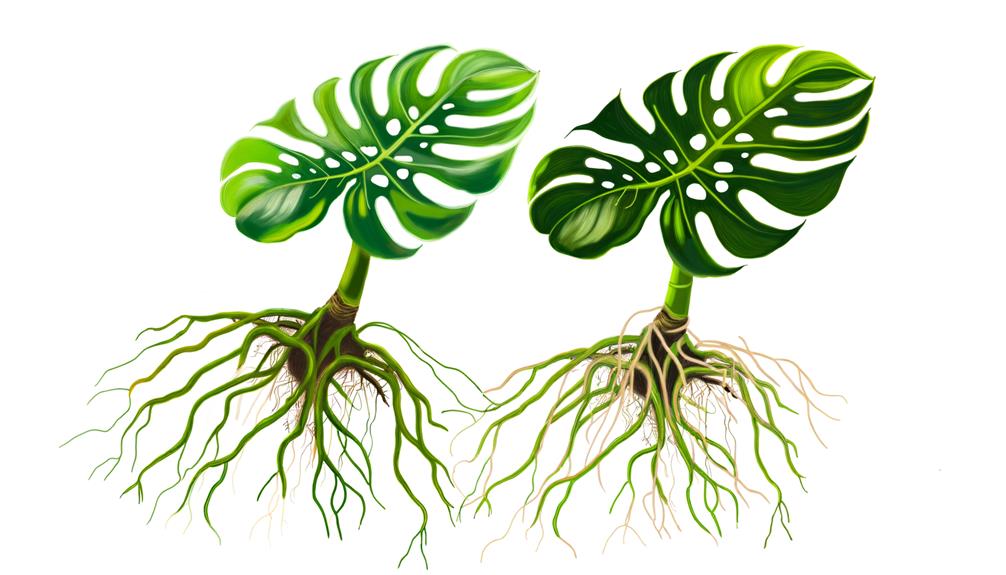
Understanding the intertwining growth patterns of Monstera deliciosa is crucial for guaranteeing both plants thrive when planted together. These plants exhibit vigorous climbing behaviors, aerial root development, and substantial leaf expansion.
When considering their growth, focus on:
- Aerial Roots: These roots help Monsteras anchor to surfaces and absorb moisture. Guarantee they’ve climbing structures.
- Leaf Fenestration: Mature leaves develop splits and holes, maximizing light capture. Provide adequate vertical space for full leaf expansion.
- Node Spacing: Nodes are critical for new leaf and root development. Monitor spacing to prevent overcrowding and competition.
Pot Size and Space
Selecting the suitable pot size is important to make sure both Monsteras have enough room for root expansion and best growth. You should choose a pot that’s at least 18-24 inches in diameter to accommodate their extensive root systems.
Monsteras, being tropical epiphytes, exhibit vigorous root development. A confined space can lead to root binding, impeding nutrient absorption and overall plant health. Guarantee the pot has adequate drainage holes, preventing water accumulation and root rot.
Additionally, consider the pot’s depth; it should be deep enough to support the vertical growth and stability of both plants. Using a well-aerated, chunky soil mix can further facilitate proper root expansion and oxygenation, promoting optimal growth conditions for your Monsteras.
Watering and Nutrition Needs
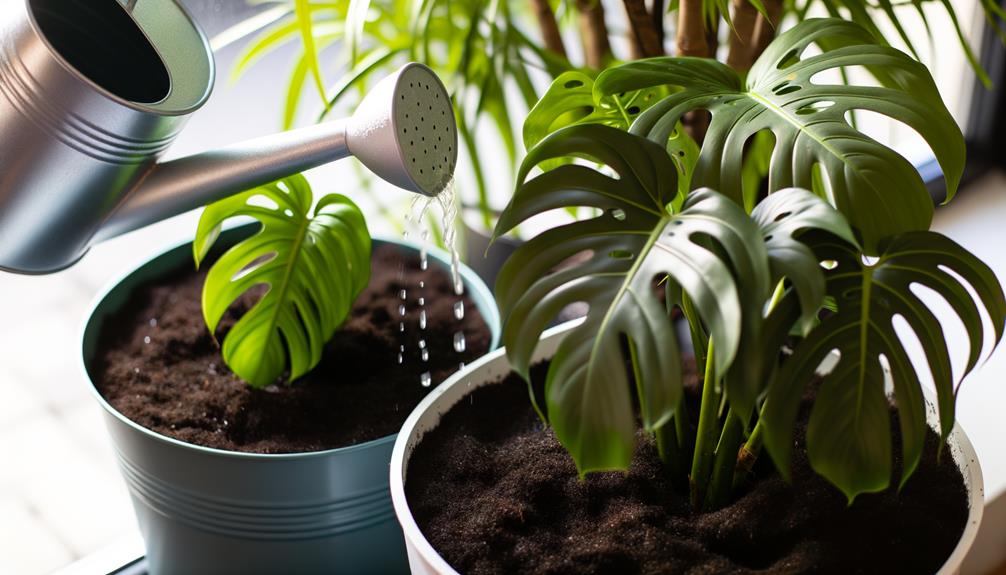
Ensuring your Monsteras receive the right amount of water and nutrients is crucial for their robust growth and overall health. Monitor soil moisture consistently, as overwatering can lead to root rot while underwatering can stunt growth. Aim to keep the soil evenly moist but not waterlogged.
For optimal nutrition:
- Fertilize Monthly: Use a balanced, water-soluble fertilizer (20-20-20) during the growing season.
- Micronutrient Supply: Supplement with micronutrients such as magnesium and calcium to promote vitality.
- pH Balance: Maintain soil pH between 5.5 and 7.0 to promote nutrient availability.
Practical Planting Tips
When planting two Monsteras together, make sure you use a pot with adequate size and well-draining soil to accommodate their rapid growth. Position the pot in an area with indirect light and maintain consistent moisture levels, avoiding waterlogged conditions.
Provide structural support as they mature to prevent damage from their expanding foliage and aerial roots.
Soil and Pot Size
Perfect soil composition and a suitably sized pot are crucial for the healthy growth of two Monsteras planted together. You’ll need a well-draining soil mix to prevent waterlogging and root rot.
Consider using a blend of:
- Peat moss for moisture retention,
- Perlite for aeration and drainage,
- Pine bark to add organic matter and improve soil structure.
Choose a pot that’s at least 20 inches in diameter to accommodate the expansive root systems of both plants. Guarantee it has drainage holes to prevent water stagnation.
Repotting every 1-2 years is recommended to maintain prime root health. Proper soil and pot size will support vigorous growth and minimize stress on your Monsteras, promoting strong foliage and overall plant health.
Light and Watering
Proper light and watering practices are essential for the best growth of two Monsteras planted together, guaranteeing their leaves remain lush and healthy.
Place your Monsteras in indirect, bright light ideally near an east or south-facing window. Direct sunlight can scorch their leaves, so diffusing the light with sheer curtains is advisable.
Watering should be thorough but infrequent; let the top inch of soil dry out before watering again. Overwatering can lead to root rot, a common issue in Monstera care. Ensure your pot has drainage holes to prevent waterlogging. Use lukewarm water and try to water in the morning to allow excess moisture to evaporate throughout the day.
Consistent humidity levels, around 60%, will also promote optimal growth.
Growth and Support
To guarantee robust growth and stability for two Monsteras planted together, consider using moss poles or trellises to support their climbing nature and aerial roots. Integrating such support structures ensures the plants can develop vertically, optimizing light exposure and minimizing competition for resources.
Here are some steps to implement:
- Install Moss Poles or Trellises Early: Position them in the pot before the roots get too established. This avoids disturbing the root system later.
- Secure Aerial Roots: Gently tie the aerial roots to the support structures using soft plant ties. This encourages the Monstera to climb.
- Monitor Growth: Regularly check the support structures and adjust ties as necessary to accommodate new growth and prevent damage.
Employ these strategies to foster healthy development.
Conclusion
Planting two monsteras together can be like raising twins. Just as twins can thrive with shared resources and mutual support, your monsteras might benefit from shared humidity and space.
However, be mindful of root competition and guarantee a sufficiently large pot. Think of it as providing a spacious nursery for twins to grow without crowding.
With proper care in watering and nutrition, your monsteras can flourish symbiotically, much like how twins can support each other’s growth.




